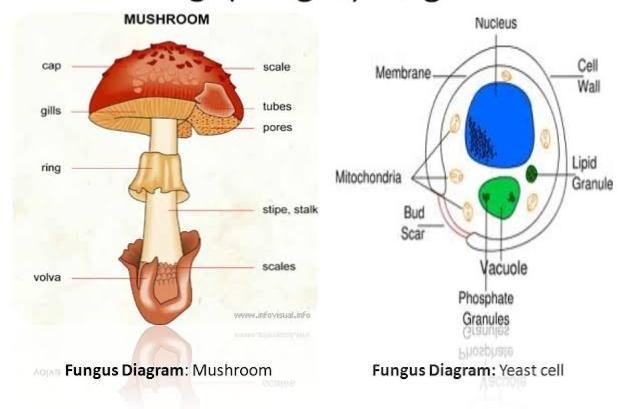Fungi: Distribution, Morphology, Reproduction, Classification
Introduction
- Fungi are heterotrophic organisms which means they require organic compound for nutrition or growth.
- Fungi are spore-bearing eukaryotes.
- Fungi may be unicellular or multicellular.
- Fungi includes moulds and yeast.
- Molds– filamentous, multicellular.
- Yeast– unicellular.
- Study of fungi is generally known as mycology.
 Distribution
Distribution
- The fungus occurs in all possible habitats i.e. aquatic, terrestrial (which grow in soil, on dead and decaying material).
- Some grow on plants and animals.
- Fungi also present in the air.
- In fungus chlorophyll are absent, so they depend on other for food. That is why fungi may be saprophytes, parasite or symbionts.
Morphology
- Yeasts cells are generally larger than most of the bacteria.
- Size of yeast ranging from 1 to 5 micrometers in width and from 5 to 30 micrometers in length.
- Flagella or other organelles of locomotion are absent in yeast.
- Cell wall constituents of fungi are mainly chitin and glucans.
- Multicellular fungi are composed of networks of long filamentous branched structure called hyphae.
- The hyphae often aggregate in a thread like dense network known as mycelium.
- The hyphae may be:
- Without crosswalls as in the case of lower fungi or, Divided into compartment by formation of septa in the higher fungi.

- Hyphae occurs in three forms:
- Coenocytic or nonseptate, such hyphae have no septa.
- Septate with uninucleate cells.
- Septate with multinucleate cells.

- The mycelium forms tissue like aggregates called the plectenchyma, in certain stages, often during transition to the sexual or asexual reproduction phase.
Reproduction
In fungi reproduction maybe asexual or sexual.
Asexual reproduction
- Asexual reproduction also known as somatic or vegetative reproduction.
- It does not involve the sex cells or sex organs and the union of nuclei.
- Asexual reproduction maybe occurs by:
- Fission of somatic cells.
- Budding of somatic cells or spores.
- Fragmentation or disjoining of the hyphal cells.
- Spore formation.
There are many kinds of asexual spores:
- Sporangiospores.
- Conidiospores or conidia(conidium).
- oidia(oidium), arthrospores.
- Chlamydospores.
- Blastospores.

Sporangiospores
- Single-celled spores.
- Formed at the end of hyphae within sacs sporangia or sporangium.
- Aplanospores: Non-motile sporangiospores.
- Zoospores- motile.
- Example- Mucor, Rhizopus.
Conidiospores or conidia(conidium)
- Microconidia is small and single-celled conidia.
- Macroconidia- large, multicellular conidia.
- They are formed at tip or side of the hyphae.
- Example– penicillium, aspergillus.
oidia(oidium), arthrospores
- These spores are single-celled formed by fragmentation of hyphae cells.
- Example– In the the milk mould Endomyces lactis.
Chlamydospores
- These single-celled sports are surrounded by thick walls are highly resistant in adverse condition.
- These are formed by vegetative hypha cells.
Blastospores
- Through boarding spores are formed.
Sexual reproduction
- It is carried out by fusion of genetic materials of two parent’s cells.
- Sexual reproduction can be divided into three phases:
- Plasmogamy- Joining of two cells and fusion of their protoplast.
- Karyogamy- This involved fusion of two haploid nuclei.
- Meiosis- Reduction of chromosomes to the haploid number.
- Gametangia- The sex organelles of fungi (if present).
- Antheridium- Male gametangia.
- Oogonium- Female gametangia.
There are various types of sexual spores
- Ascospores- Single-celled produced in sac known as Ascus.
- Basidiospores- These spores are single celled and borne on a club- shaped structure known as basidium or basidia.
- Zygospores- are big in size, thick-walled spores formed by fusion of 2 sexually compatible hyphae or gametangia.
- Oospores formed within Oogonium, produced by fertilization of oospheres by male gametes.
Fruiting bodies
- Fruiting bodies are highly organised protective structure in which sexual and sexual spores may be surrounded.
- Acervulus and pycnidium- asexual fruiting bodies.
- Perithecium and apothecium- sexual fruiting bodies.

Classification
Fungi are classified in four major divisions:
- Chytridiomycota
- Zygomycota
- Ascomycota
- Basidomycota
Chytridiomycota
- It is commonly known as chytrids.
- Habitat- Aquatic or terrestrial.
- Ploidy- Diploid.
- Motile stage- Present.
- Asexual spores- Holocarpic.
- Pathogenic relationship- Obligate parasite.
Zygomycota
- These are known as zycomycetes.
- Habitat– Terrestrial.
- Ploidy– Monoploid
- Motile stage– Absent.
- Sexual spore– Zygospores.
- Asexual spore– Sporangiospores/Chlamydospores.
- Parasitic relationship– Facultative parasite.
- Example– Black bread mould Rhizopus stolonifer.
Ascomycota
- Commonly known as Ascomycetes or sac fungi.
- Habitat– Terrestrial.
- Ploidy– Monoploid.
- Motile stage– Absent.
- Sexual spore– Ascospores.
- Asexual spore– Conidia.
- Pathogenic relationship is facultative or obligate.
Basidomycota
- It is commonly Known as basidiomycetes or club – fungi.
- Habitat– Terrestrial.
- Ploidy– Monoploid, dikaryotic.
- Motile stage– Absent.
- Asexual spore– Arthrospores, oidia, conidia.
- Sexual spore– Basidiospores.
- Pathogenic relationship is facultative or obligate parasite.
Reference and Sources
- 1% – https://www.slideshare.net/8275459522/mycoclogy
- 1% – https://namspattoki.blogspot.com/2015/03/fsc-biology-part-1-first-five-chapters.html
- 1% – http://media-2.web.britannica.com/eb-diffs/357/222357-17869-110641.html
- 1% – https://www.sciencedirect.com/science/article/pii/B9780120884834500093
- 1% – https://softnotess.blogspot.com/2017/04/mic-210.html
- 1% – https://www.scribd.com/presentation/282239190/Fungi
Also Read:
- Water as a Microbial Habitat
- Fungal Disease
- Algae : occurrence, classification and economic importance
- Introduction of Plant-Microbe Association and the Mycorrhizae
- Microbiology Disciplines: Bacteria, Viruses, Fungi, Archaea and Protists

Thanks for sharing this notes about fungi!! Keep doing this great work!! 😊
By the way, I think in this part you mean “spores”, right??
“Chlamydospores
These single-celled –sports– (spores?) are surrounded by thick walls are highly resistant in adverse condition.”
Waw that great fungi
I’m making my MSc coursework notes and found this very helpful. Thanks for sharing your valuable thoughts.
Keep up good working!
Happy Reading!